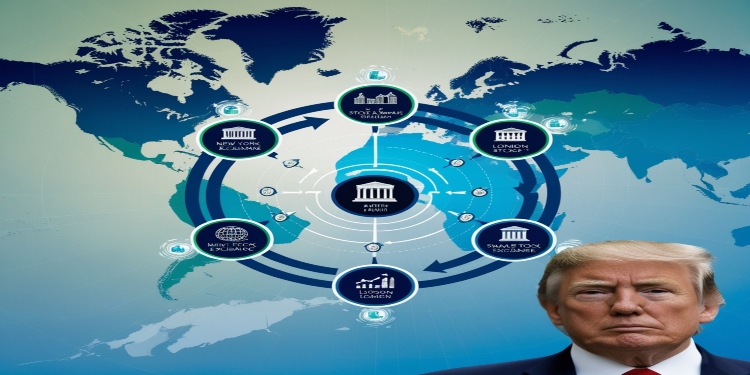Tariffs have long been used as a tool of economic leverage and protectionism, but under Donald Trump’s leadership, they evolved into a signature policy instrument with sweeping implications. From the initial waves of tariffs on Chinese goods to the more recent announcements targeting imported vehicles and copper, these measures have extended their influence well beyond trade negotiations, and they have reshaped financial markets in tangible and lasting ways.
As global economies become increasingly interdependent, any change in trade policy, especially by the United States, can ripple across asset classes, disrupt capital flows, and alter investor sentiment worldwide. Tariffs don’t just impact the industries directly targeted; they influence everything from commodity prices to currency movements and from equities to bond markets.
Role of Tariffs in Financial Markets
Tariffs are government-imposed taxes on imported goods. They are used to protect domestic industries, raise revenue, or gain leverage in trade negotiations. While tariffs are applied to products, their effects quickly extend to financial markets.
When a major economy like the United States imposes tariffs, global supply chains feel the shock. Importers may raise prices. Exporters may lose competitiveness. This creates uncertainty for businesses, investors, and consumers.
Financial markets respond to this uncertainty. Stock prices may fall. Commodities may rise. Currencies may shift direction. Even interest rate expectations can change if tariffs influence inflation or growth.
Traders and investors watch tariff announcements closely. They often trigger immediate market reactions. Over time, if the tariffs remain, they can shift longer-term economic trends. In short, tariffs send signals that financial markets cannot ignore.
Directly Affected Markets
Tariffs rarely operate in isolation. Their impact is felt across multiple financial sectors, especially those closely tied to global trade. The following markets tend to react the most directly to new or expanded tariff policies.
Equities
Stock markets are typically the first to respond. When tariffs are announced, investors reassess the outlook for entire sectors. Companies that rely heavily on imported materials or foreign sales often see their share prices drop due to concerns over costs and competitiveness.
Industries most commonly affected include:
- Automotive: Vehicle manufacturers and parts suppliers are vulnerable to both material cost increases and retaliatory tariffs.
- Manufacturing: Firms that source raw inputs globally face rising production costs and possible supply chain delays.
- Technology: U.S. and global tech companies, especially hardware producers, are exposed due to international components and global demand.
Tariff uncertainty also increases volatility. Earnings forecasts become harder to trust, and investment sentiment can shift quickly with policy developments.
Commodities
Commodities are directly affected when tariffs are applied to raw materials or essential industrial inputs. Prices tend to rise on the expectation of reduced supply or increased procurement costs.
Key commodities influenced by tariffs include:
- Copper: Widely used in construction and electronics, copper prices surged following the 2025 U.S. tariff decision.
- Aluminum and Steel: These metals often face targeted tariffs due to their strategic industrial importance.
- Agricultural products: While less relevant in recent tariff rounds, past measures significantly affected soybean and corn exports.
Tariffs can also trigger stockpiling behavior, as buyers rush to secure supply ahead of implementation. This can distort prices and create short-term demand spikes.
Currencies
Currency markets are sensitive to trade policy shifts. Tariffs can lead to changes in capital flows, import-export balances, and overall market confidence.
Common currency reactions include:
- Strengthening of the U.S. dollar in the short term as tariffs are seen as protectionist.
- Pressure on export-driven currencies, like the Chinese yuan or Mexican peso, when their goods become less competitive.
- Safe-haven flows into currencies such as the Japanese yen or Swiss franc during periods of trade tension.
Indirectly Affected Markets
While some markets react immediately to tariff announcements, others feel the impact more gradually. These markets may not be directly involved in global trade but are influenced by broader shifts in sentiment, capital flows, and economic expectations.
Fixed Income and Bonds
Bond markets tend to respond when tariffs threaten to slow economic growth or increase inflation. Investors often adjust their expectations for interest rate movements based on these risks.
Common reactions include:
- Falling yields on U.S. Treasuries, as investors seek safer assets during trade uncertainty.
- Flattening of the yield curve can signal slowing growth expectations.
- Rate cut speculation, especially if tariffs are seen as weighing on consumer demand and corporate investment.
Central banks, especially the Federal Reserve, often factor trade developments into their monetary policy outlook, which further influences bond pricing.
Precious Metals
Precious metals such as gold and silver often attract safe-haven flows during trade disputes. While they aren’t directly part of tariff lists, their value tends to rise when investors seek protection from volatility.
- Gold typically sees a surge in demand when geopolitical or economic tensions rise.
- Silver, with both industrial and investment demand, often follows gold but can also be impacted by changes in manufacturing outlook.
In the case of tariffs on industrial metals like copper or aluminum, silver may also benefit from spillover demand among commodities traders.
Logistics and Freight Indexes
Tariffs disrupt global supply chains, which affect shipping volumes, freight rates, and the performance of transportation-related assets. When tariffs are imposed, goods may be delayed, rerouted, or reduced in volume.
This can influence:
- Shipping companies and freight ETFs, often see declines during trade slowdowns.
- Port operators and logistics firms, especially those serving affected trade routes.
- Container shipping rates can fluctuate sharply as trade flows adjust to new restrictions.
Even if tariffs target a specific industry, the impact on the global movement of goods can extend across the entire logistics sector.
Tariffs Don’t Trade Alone: Watching the Domino Effect
Trump’s tariffs have proven to be more than just a political tool, they’ve become a market-moving force with wide-reaching consequences. From equity sell-offs in the automotive sector to surging prices in industrial metals, the impact of these measures can be seen across multiple corners of the financial world.
Directly affected markets like commodities, equities, and currencies often react swiftly. Meanwhile, more subtle effects unfold in bonds, precious metals, and transportation sectors. Together, they form a complex web of reactions that traders and investors must watch closely.











































































